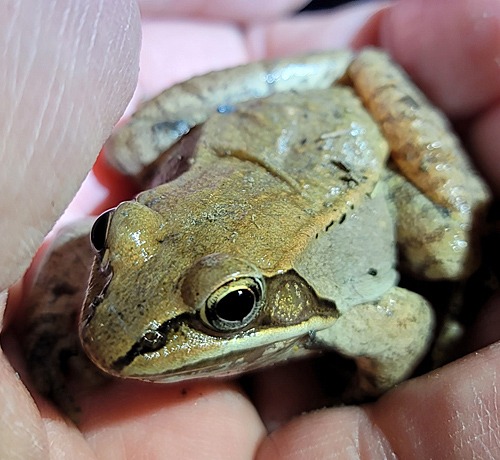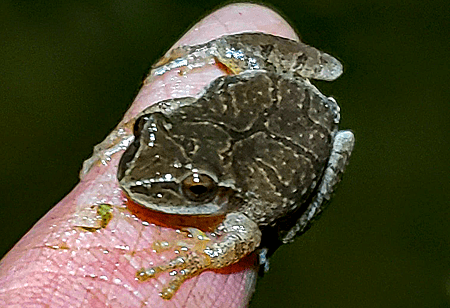Amphibian Awareness Week
Loudoun Wildlife Conservancy is celebrating Amphibian Awareness Week from May 1 to May 7 to help increase the understanding of our local amphibians, what role they play in our ecosystem, and things we can all do to help our declining amphibian populations. We’ll be highlighting our local amphibians, starting off with the Wood Frog (Lithobates sylvaticus) and the Spring Peeper (Pseudacris crucifer).

Wood Frog.
Photo by Jenny Erickson
Both frogs emerge in late winter or early spring and migrate to temporary or vernal pools to reproduce. These frogs are the first ones we hear in Loudoun County.
The Wood Frog averages between 2-3 inches in length and can range in color from tan to dark brown, even red and orange tones! They have a darker mask that covers each eye, allowing for easier identification. Our Wood Frog is quite a special amphibian as it is the only frog species that lives above the arctic circle! They have the ability to freeze solid during the winter using a biological process which allows ice to form outside the cells while preventing ice from forming inside the cells. Listen to Wood Frog call
Our Spring Peeper is also an early spring breeder and are very recognizable by their loud call. For such a loud call, Spring Peepers come in a very small package, averaging approximately one inch in length. People often say that they have never seen a Spring Peeper and are surprised by their diminutive size. The peepers with the louder and better quality call have a higher chance of breeding. If the weather is warm in the fall, you may also be lucky enough to hear an encore of the peeper chorus, as they often will start calling again on the warm early autumn evenings. Listen to Spring Peeper call

Spring Peeper.
Photo by Jenny Erickson
The Wood Frog is one of our local vernal pool indicator species, which means they breed almost exclusively in the vernal pools and depend upon vernal pools for their survival. The Spring Peeper is one of our local facultative species, which means they will also use other suitable wetlands in addition to vernal pools for breeding.
What is a vernal pool? It is a unique type of wetland habitat. They can vary in size, but are often smaller, shallow seasonal pools with no permanent inlet or outlet. They are filled by rain and snow, often in the middle to late winter in our area, and then as the precipitation decreases and temperatures increase, they dry up by summer. A big advantage to using a vernal pool as a breeding location, and for larval amphibians to develop, is that these temporary pools lack fish, making it a safer environment. Given that these pools only hold water for a short period of time (averaging three months in our area), most of the amphibians who use these pools to breed are more easily visible in the late winter and early spring. We have several species of amphibians in our area that are considered vernal pool indicator species. These local species are: Spotted Salamander (Ambystoma maculatum), Jefferson Salamander (Ambystoma jeffersonianum), Marbled Salamander (Ambystoma opacum), Wood Frog (Lithobates sylvaticus), Eastern Spadefoot (Scaphiopus holbrookii), and Fairy shrimp (Eubranchipus spp.). Yes, vernal pools contain freshwater shrimp!
What can we do? Preservation of these vernal pools is key to preservation of the species that depend on them. Vernal pools are often underrated in their importance and are also hard to identify when they are dry. The biggest threat to our vernal pools is the loss of this habitat due to development. Through education and advocacy, we all can help preserve these sensitive wetlands.
The post Amphibian Awareness Week appeared first on Loudoun Wildlife Conservancy.



